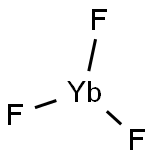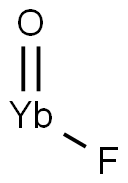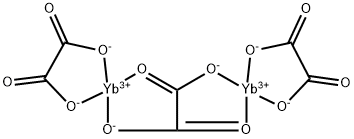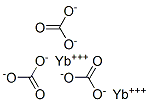YTTERBIUM FLUORIDE
Synonym(s):Ytterbium trifluoride;Ytterbium(III) fluoride
- CAS NO.:13760-80-0
- Empirical Formula: F3Yb
- Molecular Weight: 230.04
- MDL number: MFCD00049615
- EINECS: 237-354-2
- SAFETY DATA SHEET (SDS)
- Update Date: 2024-12-18 14:07:02

What is YTTERBIUM FLUORIDE?
Chemical properties
white to off-white powder
The Uses of YTTERBIUM FLUORIDE
Ytterbium Fluoride is applied to numerous fiber amplifier and fiber optic technologies, High purity grades are widely applied as a doping agent for garnet crystals in lasers a important colourant in glasses and porcelain enamel glazes. Ytterbium Fluoride is a water insoluble Ytterbium source for use in oxygen-sensitive applications, such as metal production.
The Uses of YTTERBIUM FLUORIDE
Ytterbium Fluoride is a useful compound in the manufacturing process of aluminum nitride powder.
Flammability and Explosibility
Not classified
Properties of YTTERBIUM FLUORIDE
| Melting point: | 1157 °C |
| Boiling point: | 2200 °C |
| Density | 4.01 g/mL at 25 °C(lit.) |
| refractive index | 1.54 |
| solubility | insoluble in H2O |
| form | Powder |
| color | white |
| Specific Gravity | 8.168 |
| Water Solubility | Soluble moderately in strong mineral acids. Insoluble in water. |
| Sensitive | Hygroscopic |
| Exposure limits | ACGIH: TWA 2.5 mg/m3 NIOSH: IDLH 250 mg/m3 |
| Stability: | hygroscopic |
| CAS DataBase Reference | 13760-80-0(CAS DataBase Reference) |
| EPA Substance Registry System | Ytterbium fluoride (YbF3) (13760-80-0) |
Safety information for YTTERBIUM FLUORIDE
| Signal word | Danger |
| Pictogram(s) |
 Skull and Crossbones Acute Toxicity GHS06 |
| GHS Hazard Statements |
H302:Acute toxicity,oral H312:Acute toxicity,dermal H315:Skin corrosion/irritation H319:Serious eye damage/eye irritation H331:Acute toxicity,inhalation H335:Specific target organ toxicity, single exposure;Respiratory tract irritation |
| Precautionary Statement Codes |
P261:Avoid breathing dust/fume/gas/mist/vapours/spray. P280:Wear protective gloves/protective clothing/eye protection/face protection. P304+P340:IF INHALED: Remove victim to fresh air and Keep at rest in a position comfortable for breathing. P305+P351+P338:IF IN EYES: Rinse cautiously with water for several minutes. Remove contact lenses, if present and easy to do. Continuerinsing. P405:Store locked up. P403+P233:Store in a well-ventilated place. Keep container tightly closed. |
Computed Descriptors for YTTERBIUM FLUORIDE
New Products
(S)-3-Aminobutanenitrile hydrochloride 4-Methylphenylacetic acid N-Boc-D-alaninol N-BOC-D/L-ALANINOL Tert-butyl bis(2-chloroethyl)carbamate 3-Morpholino-1-(4-nitrophenyl)-5,6-dihydropyridin- 2(1H)-one Furan-2,5-Dicarboxylic Acid Tropic acid 1-Bromo-3,5-Di-Tert-Butylbenzene S-2-CHLORO PROPIONIC ACID ETHYL ISOCYANOACETATE 2-Bromo-1,3-Bis(Dimethylamino)Trimethinium Hexafluorophosphate 4-IODO BENZOIC ACID 3-NITRO-2-METHYL ANILINE 1-(2,4-DICHLOROPHENYL) ETHANAMINE (2-Hydroxyphenyl)acetonitrile 4-Bromopyrazole 2-(Cyanocyclohexyl)acetic acid 4-methoxy-3,5-dinitropyridine 1-(4-(aminomethyl)benzyl)urea hydrochloride 2-aminopropyl benzoate hydrochloride diethyl 2-(2-((tertbutoxycarbonyl)amino) ethyl)malonate tert-butyl 4- (ureidomethyl)benzylcarbamate Ethyl-2-chloro((4-methoxyphenyl)hydrazono)acetateRelated products of tetrahydrofuran








You may like
-
 Ytterbium(III) fluoride, Anhydrous CAS 13760-80-0View Details
Ytterbium(III) fluoride, Anhydrous CAS 13760-80-0View Details
13760-80-0 -
 Ytterbium(III) fluoride, Anhydrous CAS 13760-80-0View Details
Ytterbium(III) fluoride, Anhydrous CAS 13760-80-0View Details
13760-80-0 -
 Ytterbium(III) fluoride, Anhydrous CAS 13760-80-0View Details
Ytterbium(III) fluoride, Anhydrous CAS 13760-80-0View Details
13760-80-0 -
 Ytterbium(III) fluoride, Anhydrous CAS 13760-80-0View Details
Ytterbium(III) fluoride, Anhydrous CAS 13760-80-0View Details
13760-80-0 -
 Ytterbium(III) fluoride, Anhydrous CAS 13760-80-0View Details
Ytterbium(III) fluoride, Anhydrous CAS 13760-80-0View Details
13760-80-0 -
 Ytterbium(III) fluoride, Anhydrous CAS 13760-80-0View Details
Ytterbium(III) fluoride, Anhydrous CAS 13760-80-0View Details
13760-80-0 -
 YTTERBIUM FLUORIDE CAS 13760-80-0View Details
YTTERBIUM FLUORIDE CAS 13760-80-0View Details
13760-80-0 -
 Ytterbium(III) fluoride, 99.99% CAS 13760-80-0View Details
Ytterbium(III) fluoride, 99.99% CAS 13760-80-0View Details
13760-80-0
Statement: All products displayed on this website are only used for non medical purposes such as industrial applications or scientific research, and cannot be used for clinical diagnosis or treatment of humans or animals. They are not medicinal or edible.